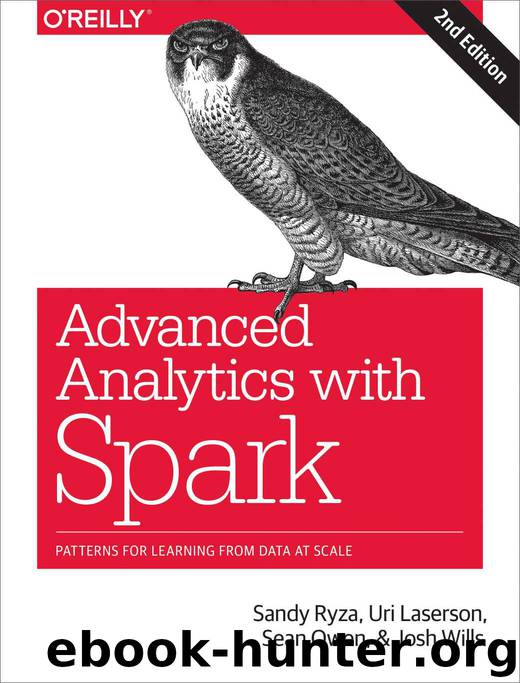Advanced Analytics with Spark: Patterns for Learning from Data at Scale by Sandy Ryza & Uri Laserson & Sean Owen & Josh Wills

Author:Sandy Ryza & Uri Laserson & Sean Owen & Josh Wills [Ryza, Sandy]
Language: eng
Format: azw3
Publisher: O'Reilly Media
Published: 2017-06-12T04:00:00+00:00
Finding Important Concepts
So SVD outputs a bunch of numbers. How can we inspect these to verify they actually relate to anything useful? The V matrix represents concepts through the terms that are important to them. As discussed earlier, V contains a column for every concept and a row for every term. The value at each position can be interpreted as the relevance of that term to that concept. This means that the most relevant terms to each of the top concepts can be found with something like this:
import org.apache.spark.mllib.linalg.{Matrix, SingularValueDecomposition} import org.apache.spark.mllib.linalg.distributed.RowMatrix def topTermsInTopConcepts( svd: SingularValueDecomposition[RowMatrix, Matrix], numConcepts: Int, numTerms: Int, termIds: Array[String]) : Seq[Seq[(String, Double)]] = { val v = svd.V val topTerms = new ArrayBuffer[Seq[(String, Double)]]() val arr = v.toArray for (i <- 0 until numConcepts) { val offs = i * v.numRows val termWeights = arr.slice(offs, offs + v.numRows).zipWithIndex val sorted = termWeights.sortBy(-_._1) topTerms += sorted.take(numTerms).map { case (score, id) => (termIds(id), score) } } topTerms }
Download
This site does not store any files on its server. We only index and link to content provided by other sites. Please contact the content providers to delete copyright contents if any and email us, we'll remove relevant links or contents immediately.
Deep Learning with Python by François Chollet(12956)
Hello! Python by Anthony Briggs(10198)
The Mikado Method by Ola Ellnestam Daniel Brolund(10106)
OCA Java SE 8 Programmer I Certification Guide by Mala Gupta(10043)
Dependency Injection in .NET by Mark Seemann(9580)
Algorithms of the Intelligent Web by Haralambos Marmanis;Dmitry Babenko(8587)
Grails in Action by Glen Smith Peter Ledbrook(7941)
Becoming a Dynamics 365 Finance and Supply Chain Solution Architect by Brent Dawson(7902)
Test-Driven iOS Development with Swift 4 by Dominik Hauser(7899)
The Well-Grounded Java Developer by Benjamin J. Evans Martijn Verburg(7840)
Microservices with Go by Alexander Shuiskov(7666)
Practical Design Patterns for Java Developers by Miroslav Wengner(7561)
Test Automation Engineering Handbook by Manikandan Sambamurthy(7496)
Angular Projects - Third Edition by Aristeidis Bampakos(6974)
Secrets of the JavaScript Ninja by John Resig Bear Bibeault(6739)
The Art of Crafting User Stories by The Art of Crafting User Stories(6427)
NetSuite for Consultants - Second Edition by Peter Ries(6377)
Demystifying Cryptography with OpenSSL 3.0 by Alexei Khlebnikov(6172)
Kotlin in Action by Dmitry Jemerov(5367)
